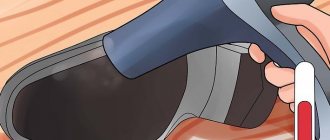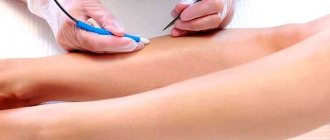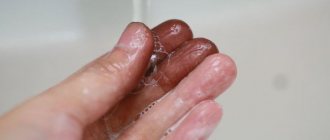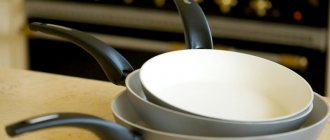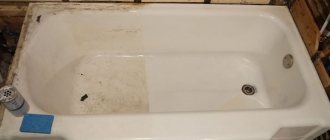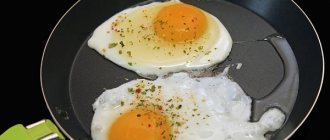Proper care of ceramics
Ceramics are among the wear-resistant and at the same time thin and fragile coatings. It will serve faithfully for a long time, but only with proper use.
The frying pan should not be immediately thrown into the cooking hole. It is recommended that you read the manufacturer's recommendations before first use. Many, for example, advise washing dishes without using detergents.
Tips to extend the effective life of your ceramic frying pan:
Caring for ceramic cookware excludes the use of coarse abrasives, metal sponges, spatulas and scrapers - the coating is easy to scratch. It is recommended to avoid products using alkali, chlorine and ammonia. Many dishwashing detergents contain acids, which can shorten their service life.
Therefore, always pay attention to the composition of the washing gel. Baking soda is contraindicated for cleaning ceramic coatings. It destroys the fragile layer that is responsible for the non-stick properties of the pan. Washing and cleaning should be carried out after complete cooling. After each use, it is recommended not only to rinse the pan, but also to dry it to remove excess moisture.
Storing ceramic dishes with drops of water on the surface is unacceptable.
It is not recommended to use dishwashing gels unless absolutely necessary. The use of a dishwasher is permitted, but should not be abused. Hand washing remains preferable. When washing, both in the machine and by hand, the water temperature should not exceed 40 degrees. Storage should not be carried out in close contact with metal products. If there is no way out, then a barrier of paper or fabric is created to prevent scratches and cracks.
Following the recommendations for use, care and cleaning will allow you to preserve the valuable qualities of the ceramic coating on the frying pan for the maximum amount of time.
Effective methods for cleaning your iron at home
To quickly clean your iron, you can seek help from the popular collection of tips, which offers many cleaning options. Moreover, all these methods are based on the use of improvised means available in every home.
Whatever cleaning method is chosen, it must match the material of the sole. In the case of a ceramic coating, it is desirable that the mechanical impact be minimized, and the carbon deposits must first be melted and dissolved.
Prohibited:
Scrape carbon deposits from the sole with a knife or wire brush.
Rub the coating with sandpaper.
Use abrasive substances.
The following products will help you effectively clean ceramic soles:
Cleaning Pencil
For a ceramic surface, you should buy a pencil based on ammonia. The cleaning procedure is as follows:
1. The iron is heated to maximum temperature and unplugged.
2. Install the device in a vertical or slightly inclined position.
3. Use a pencil to treat the surface of the sole. Under the influence of temperature, it will begin to melt and flow together with the dirt.
4. Remove any remaining melted pencil and carbon deposits with a clean, dry cloth.
Household chemicals for cleaning glass-ceramic surfaces
This option is suitable for those who have a glass-ceramic hob installed in their kitchen. They already have products for caring for such a surface - these can be used to clean the ceramic soleplate of the iron.
They do this: apply a product from the arsenal of household chemicals for glass ceramics to the cold surface of the device. Leave the substance to act for 5–10 minutes, after which the dirt is collected and the sole is polished with a dry soft cloth.
Vinegar and ammonia
These two components do an excellent job of removing carbon deposits, both together and separately. If you plan to clean the iron with vinegar, then the device is heated to maximum temperature, but when using ammonia, it is heated slightly. In both cases, after heating, the iron is turned off from the network. Then soak a thick cloth in the selected substance and wipe the sole.
To make a solution, take these 2 substances, ammonia and acetic acid, in equal proportions, mix. Then proceed like this:
1. Moisten a sponge in the resulting composition and apply it to a cold surface. 2. Heat up the iron. 3. Take a clean cotton cloth, moisten it in a solution, and spread it on the surface. 4. Iron this fabric several times with a heated iron.
Hydrogen peroxide
The warm sole of the iron, already unplugged, is wiped with a cotton swab dipped in a solution of hydrogen peroxide. Repeat the procedure several times until the carbon deposits peel off.
Toothpaste
Using toothpaste, you can quickly and easily clean the soleplate of your iron. To do this, you need to warm up the device and turn it off. Take a sponge or an old toothbrush and apply an even, thin layer of paste to the surface to be treated. Wait for the substance to dry, then remove any remaining paste with a soft, dry cloth.
Toilet soap
This method is good when you have just placed a stain and decided to get rid of it immediately. This technique will not work with old stains.
What do we have to do:
- Wait until the soleplate of the iron cools down a little.
- Take soap and rub it on the damaged surface.
- Leave the device for 30 minutes.
- Use a damp soft cloth to remove any remaining soap and dirt.
- Polish the surface with a dry cloth.
Nail polish remover
A solution containing acetone will do an excellent job of removing stains such as pieces of burnt synthetics and polyethylene. The cleaning method is simple: heat the iron slightly and turn it off. Soak a cotton swab in nail polish remover and rub the stained area. The stain will disappear right before your eyes.
Matchbox
An unusual, but quite effective method. It is better to take a new matchbox, since we will need a dark side. This is where sulfur is found, which perfectly corrodes dirt.
Cleaning method:
1. Preheat the iron and turn it off. 2.Rub the carbon deposits with the dark side of the matchbox. 3.As soon as the stains come off, remove any remaining dirt with a damp soft cloth.
Cleaning combs of different shapes
Massage
The difficulty of cleaning a massage comb lies not so much in the cleaning method itself, but in the subsequent drying of the product. The fact is that the design of the massage brush allows moisture to flow into hard-to-reach places, for example, under the rubber base into which the teeth are inserted. If you don’t dry the massager enough, mold can form there, and in general, moisture is a favorable environment for the development of bacteria.
How to wash a massage comb:
- Carefully remove all hair using your hands, a toothpick, or a skewer;
- Wipe all parts with alcohol - each tooth, the lining itself, the body;
- Change the cotton pad and repeat the previous step.
If you still decide to soak the combs, then do it taking into account the material of the body and teeth, as well as subsequent thorough drying. For your own peace of mind, you can use a hairdryer - thoroughly blow the instrument with warm or cold air, especially in areas of potential water accumulation.
Scallop
A comb and any types of simple combs with or without a handle are perhaps the least problematic in terms of cleansing. Depending on the material used, the comb can be soaked, wiped, or cleaned.
How to wash a comb:
- By rubbing. With a cotton pad and ammonia, 70% alcohol. It is important to wipe each tooth, the handle, if there is one, and the butt - particles of fat, dust and dirt also accumulate there;
- Cleaning. Baking soda and toothbrush;
- By soaking. In a solution of shampoo and ammonia, powder, liquid soap, laundry soap, vinegar - depending on the type of material.
Brushing
But cleaning round combs is a real test for your nerves. Hair that falls out during the styling process gets wrapped around the entire circumference, which makes it almost impossible to quickly remove it, especially with your fingers.
How to clean a brushing comb:
- To remove hair, use tweezers. It is convenient for them to pick up hair and pull it out;
- Rinse the instrument thoroughly under running water;
- Soak in soap or other solution. Wiping a brush is practically useless, since the design includes many small bristles that are physically impossible to wipe properly, so only soaking.
What can you soak brushing combs in:
- In a solution of washing powder - 1.5 tsp. per glass of water;
- In a solution of shampoo and with the addition of ammonia - a liter of water, 3 tbsp. l. shampoo, 5 drops of alcohol;
- In vinegar - 2 tbsp per liter of water. l vinegar 9%.
After cleaning, be sure to sushi the tool, you can, like massage, use a hairdryer, especially if the inside of the round comb is closed.
How not to clean ceramics
The ceramic surface requires careful cleaning.
The following should not be used to clean the soleplate of the ironing device:
- products containing abrasives;
- rough napkins;
- metal scourers.
Cleaning products with an abrasive effect include silica, feldspar, pumice, and minerals. They are used to remove heavy dirt, and with this product you can damage the sole, leaving scratches.
It is important to know that only clean, soft cloths or microfiber cloths are used to clean the device. It is better not to use rags that are used for cleaning the kitchen and other rooms.
Rules to follow when cleansing:
- Before ironing, study the label on the clothing in detail;
- set the mode correctly;
- Products made of wool and synthetics, so as not to burn, should be ironed through damp gauze or thin cotton cloth;
- use only filtered or boiled water;
- After ironing, wipe the sole with a cloth;
- Drain the remaining water from the tank.
Careful handling will extend the life of the electrical appliance, and ironing will not be a troublesome task. Ironed favorite things will only make you happy!
How to clean a ceramic-coated hair straightener from carbon deposits: basic methods
Every young lady dreams of looking elegant and impressive, but without a beautiful and fashionable hairstyle this is impossible. To create stylish looks, women buy curling irons and flat irons.
The ceramic device helps to make straight and even curls out of curls, and to create a stylish hairstyle with protruding strands.
How you clean your hair straightener determines whether the ends will split, the curls will straighten evenly, and how many years the device will work.
Why clean your curling iron?
To strengthen their hair, women rub in oils. To ensure that the hairstyle lasts longer and the curls do not fall apart, use foam and varnish. All these funds settle on the device.
Uneven heating of the plates
When you turn on the iron, the temperature increases, under the influence of which accumulated residues of cosmetics and medicinal oils stick to the surface of the plates. If hair that is not very clean is straightened, sebum remains on the curling iron. The resulting sticky layer:
- prevents uniform heating of the plates;
- negatively affects the condition of the hair;
- reduces the effect of the procedure.
Over time, the strands begin to fall off. To prevent this from happening, you need to clean the curling iron from plaque.
Damage to the work surface
Sticky particles of varnish, fat, foam worsen the appearance of the device and make it untidy. Carbon deposits that form on the parts of the device lead to damage to its surface.
No effect from leveling
A curling iron coated with plaque begins to work worse because the plates heat up unevenly. In some areas, the temperature is lower than normal, and curly curls are poorly aligned, do not acquire a beautiful shine, but, on the contrary, become dull because they become dirty from the surface of the iron, which is covered with a greasy coating.
Overheating and split ends
Since the effect of hair straightening is reduced, it takes longer to expose the strands to high temperatures, which negatively affects the condition of the ends. They begin to peel off and split heavily.
Ceramic coating
Many women try to scrub away carbon deposits on their curling irons with cleaning products that scratch the surface of the hair straightener. Ironing plates are made not only of metal, but also of ceramics. The device should not be wiped with abrasive powders, but with a cloth soaked in heated water or soap solution.
How not to do it
If you straighten dirty hair, greasy deposits quickly accumulate on the iron plates. Before the procedure, you must wash your hair. Wet curls cannot be straightened or curled, just as it is forbidden to use a wet iron.
It is dangerous to clean the appliance when it is not unplugged, as this may cause a short circuit. Abrasive products scratch the ceramic coating of the curling iron; under no circumstances should you remove carbon deposits with your fingernails, a knife or a blade.
The device must be heated to a certain temperature. It is recommended to straighten brittle and dry strands at 120–140 °C. To work with coarse and thick curls, the device can be heated to 200–220 °C.
Increasing the maximum parameters negatively affects the hair structure, split ends, strands become brittle and dull.
Rules of care and use
Women who not only dream of looking stunning, always having a stylish hairstyle, but also maintaining shine and health in their curls are advised to purchase a more expensive straightener with ceramic coating. The heat in such a straightener evenly enters the plate, protecting the hair from overheating.
In a device made entirely of metal, the temperature rises unevenly, and it is easy to burn out the curls, and it is much more difficult to restore them. Before plugging the iron into a socket, you need to check whether the insulation and parts of the device are damaged. To prevent a short circuit, if the first If there are any signs of a dangerous phenomenon, the curling iron cord must be unplugged.
Do not straighten or twist wet strands; if the insulation is broken, you may receive an electric shock. And even if this does not happen, the hair structure suffers.
Dirty hair contains a lot of sebum and contains remnants of cosmetics and care products. These particles stick to the surface of the plates, melt, forming carbon deposits, which are difficult to deal with. It is necessary to select the temperature regime for straightening curls, taking into account the thickness and density of the hair.
The contaminated surface must be cleaned after turning off the device with a cloth soaked in warm, but not hot or cold water. Do not pry the coating on the iron with sharp objects, or rub the surface of the curling iron with abrasive powders or hard sponges.
Precautionary measures
Since the rectifier is an electrical appliance, precautions should be taken when cleaning it. This will protect you and your loved ones from injury.
Follow these rules:
- Under no circumstances should you begin cleaning the iron unless it is unplugged.
- Clean away from children and pets. Especially during heating.
- Do not immerse the device in cleaning solution. This is life-threatening and can completely damage the rectifier.
- Do not plug a wet iron into a power outlet.
Rules of care and use
Women who not only dream of looking stunning, always having a stylish hairstyle, but also maintaining shine and health in their curls are advised to purchase a more expensive straightener with ceramic coating. The heat in such a straightener evenly enters the plate, protecting the hair from overheating.
In a device made entirely of metal, the temperature rises unevenly, and it is easy to burn out the curls, and it is much more difficult to restore them. Before plugging the iron into a socket, you need to check whether the insulation and parts of the device are damaged. To prevent a short circuit, if the first If there are any signs of a dangerous phenomenon, the curling iron cord must be unplugged.
Do not straighten or twist wet strands; if the insulation is broken, you may receive an electric shock. And even if this does not happen, the hair structure suffers.
Dirty hair contains a lot of sebum and contains remnants of cosmetics and care products. These particles stick to the surface of the plates, melt, forming carbon deposits, which are difficult to deal with. It is necessary to select the temperature regime for straightening curls, taking into account the thickness and density of the hair.
The contaminated surface must be cleaned after turning off the device with a cloth soaked in warm, but not hot or cold water. Do not pry the coating on the iron with sharp objects, or rub the surface of the curling iron with abrasive powders or hard sponges.
Hair straightening is a fairly popular salon and home procedure. Modern devices allow you to tame even the most unruly curls, making them even, smooth and shiny. However, over time, a layer of plaque and soot from care and styling products accumulates on the heating plates and body. In this case, you should immediately clean your hair straightener so as not to damage your hairstyle. This is not difficult to do, but there are some nuances in the technique.
Precautionary measures
Since the rectifier is an electrical appliance, precautions should be taken when cleaning it. This will protect you and your loved ones from injury.
Follow these rules:
- Under no circumstances should you begin cleaning the iron unless it is unplugged.
- Clean away from children and pets. Especially during heating.
- Do not immerse the device in cleaning solution. This is life-threatening and can completely damage the rectifier.
- Do not plug a wet iron into a power outlet.
Additional Cleaning and Prevention Tips
- If you burn the fabric and its traces remain on the sole, immediately apply a cotton rag soaked in cold water to the stained area. A sudden change in temperature will help peel off the burnt fabric from the metal.
- Do not use metal sponges or hard brushes to clean the soleplate of the iron, especially if it has a Teflon or ceramic coating. Also, to avoid scratching the metal, avoid using abrasive cleaners.
- To reduce scale and rust deposits inside the iron, each time after ironing, while the appliance is still warm, pour out all remaining water from it.
- To delay descaling your iron, try to use filtered water for steaming.
And finally, we suggest watching a useful video on how to clean an iron with a metal, ceramic or Teflon sole using folk and special means.
- How to descale a kettle - 6 home remedies
- How to clean a frying pan outside and inside - 12 best ways
- How to clean a pan outside and inside - 8 simple ways for difficult cases
- 5 ways to clean the oven from grease and carbon deposits
- How to wash kitchen towels to perfect condition - 7 ways
- 8 ways to clear clogged pipes
- Rating of washing powders 2022 and guide to choosing
General recommendations
Before cleaning the soleplate of a household appliance, you should familiarize yourself with the basic rules for cleaning and, in general, handling the iron. Since the goal is not just to clean the dirty coating, but also to keep it intact and unharmed, under no circumstances should you use rough, abrasive products; ceramics do not tolerate this. This is the most important rule. Besides:
- Do not press too hard on the sole - it may crack.
- You cannot clean a hot iron - first you need to turn it off from the power supply and allow the device to cool, unless the instructions indicate that you need to clean the hot soleplate.
- You should not start ironing immediately after cleaning, as this can have a negative impact on both the device and things.
Next, you should decide which means are more suitable for you - professional or folk.
How often should I clean the device?
The more often you remove plaque from the plates, the better for your hair and the device itself. Stylists recommend cleaning your flat iron once a week if you use it every day without additional cosmetics. In the case of treating curls with varnish, foam and other stylers, the plaque must be washed off after every second use.
Remember that even heat protectants remain on the surface of the straightener. And if you cannot see them, you should not ignore the rules for caring for the device.
Cleaning carbon deposits at home
When choosing a pencil for cleaning a ceramic iron, make sure that the main component of the product is ammonia or acid. The ceramic sole must be cleaned with a pencil very carefully.
Carelessness can lead to scratches on the coating, which will impair ironing and subsequent surface care. The pencil is very easy to use:
The pencil is very easy to use:
- turn on the iron and wait until the soleplate heats up;
- carefully move the pencil over the ceramic coating, pressing lightly in places where the contamination is significant;
- unplug the iron and wait until it cools down;
- Wipe the ceramic coating with a damp soft cloth or napkin.
By choosing a glass ceramic cleaning product, it will be easy to remove dirt from the sole. Apply the product to the ceramic surface of the iron in the amount specified in the instructions for the cleaning composition. Wait 3-5 minutes and polish the surface with a cloth. Such products will help remove dirt from the soleplate of the iron and clean the glass-ceramic stove, if you have such cooking equipment in your household.
Table vinegar also effectively copes with stains on ceramic soles. Set the iron to the maximum temperature, wait until it heats up and disconnect the device from the power supply. Dip a soft cloth in vinegar and rub the dirty areas of the sole.
Having chosen hydrogen peroxide for cleaning, you will additionally need a piece of linen cloth.
- Set the appropriate mode for ironing linen and turn on the iron.
- While the ceramic soleplate is heating, generously soak a linen cloth in peroxide and place it on the ironing surface.
- Iron the linen to remove dirt from the sole. When the fabric dries, re-wet it in peroxide and continue ironing until the dirt is completely removed.
- After cleaning the ceramic surface, take cotton swabs and soak them in peroxide to remove dirt from the steam holes.
At home, the easiest folk remedy to find is toothpaste, but do not use a hygiene product with a whitening effect to clean your ceramic-coated iron. Make the sole warm, but not hot, and apply the paste. When it dries, use a soft cloth to remove any deposits that have formed.
Any carbon deposits that appear can be cleaned immediately using laundry soap. Rub the warm ceramic coating of the iron with soap and after 25-30 minutes, clean the deposits with a damp cloth. Cotton swabs will help remove dirt in the steam holes.
When using ammonia as a cleaning agent, ensure that the room is well ventilated. Set the iron to the minimum temperature, turn it on and wait for it to heat up, unplug the device from the outlet. Wet a cloth with ammonia and treat the ceramic sole. After waiting 2-3 minutes, dip the rag again in ammonia and rub the dirty areas of the iron’s ceramic coating.
Cleaning methods
The method for cleaning the device depends on the degree of contamination. If you straighten only clean hair without using styling or protective products, the task will be much easier. If cosmetic residues have stuck to the surface, you will have to use more effective methods.
Simple method
To clean the hair straightener, we need a microfiber or a thin terry towel; they must be clean. You also need to prepare cotton sponges and ear buds, warm water (in no case cold or hot). Next we proceed according to this scheme:
Plug in the device and heat the plate until warm. They should not be hot, otherwise there is a risk of getting burned, and it is simply impossible to remove dirt from a cold surface. Disconnect the rectifier from the mains, keeping the plug away from water. We wet the towel, wring it out well, wrap it around our fingers and smoothly walk over the plates
It is very important not to scrape or rub off the carbon deposits with your fingernails or improvised means, as this can damage the coating of the iron. To clean hard-to-reach places, use cotton sponges or swabs. After removing dirt from the working surface, we move on to the body. It must be cleaned, especially if you use the iron not only for straightening, but also for creating curls.
Removing stubborn stains
How to clean hair straighteners from hairspray, mousse, oils and other cosmetics? It is more difficult to wash the coating from such contaminants, but it is quite possible. To make your task easier, after each use of the device, treat the work surfaces and body with alcohol-containing wet wipes or a dry paper towel.
If the plaque layer is large, use a solution of warm water and liquid soap. You can use rubbing alcohol instead of detergent.
However, keep in mind that its concentration should be low, otherwise there is a risk that the paint will peel off the rectifier body. After removing dirt, be sure to go over the iron with a damp, clean towel to remove any remaining product.
How often should I clean the device?
The more often you remove plaque from the plates, the better for your hair and the device itself. Stylists recommend cleaning your flat iron once a week if you use it every day without additional cosmetics. In the case of treating curls with varnish, foam and other stylers, the plaque must be washed off after every second use.
Remember that even heat protectants remain on the surface of the straightener. And if you cannot see them, you should not ignore the rules for caring for the device.
What is soot and where does it come from?
The frying pan is intended mainly for frying various foods, which means that the dishes are in constant contact with molecules of fats of vegetable and animal origin. During the cooking process, splashes of oil fall on the outer surface of the cookware and, under the influence of high temperature, are “welded” to it.
Over time, burnt fat accumulates on the outside and, as a result, a fairly dense layer of dark brown color is formed. This is called carbon deposits, which must be removed immediately, since the fight against old deposits will be much longer and more difficult.
